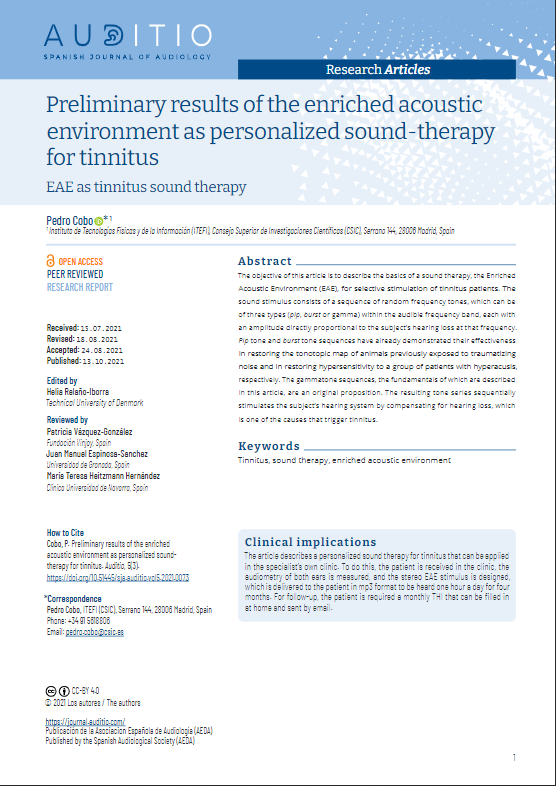Preliminary results of an Enriched Acoustic Environment as personalised sound therapy for tinnitus
EAE as sound therapy of tinnitus
DOI:
https://doi.org/10.51445/sja.auditio.vol5.2021.0073Keywords:
Tinnitus, sound therapy, Enriched Acoustic EnvironmentAbstract
The aim of this article is to describe the fundamentals of a sound therapy, named Enriched Acoustic Environment, for the selective stimulation of tinnitus patients. The sound stimulus consists of three types of tones (pip, burst, and gamma) of random frequency, within the audible frequency band, each one with amplitude proportional to the hearing loss value at that frequency. The tone pip and tone burst already demonstrated their efficacy in the restoration of the cortical tonotopic map of cats previously exposed to a traumatizing noise, and the restoration of the hypersensibility of a human group of hyperacusis patients, respectively. The gamma tones sequence, which acoustical fundamentals are described in the article, are an original proposal. The resulting tone sequence stimulates selectively the auditory system of the subject by compensating its hearing loss, which is a possible trigger of tinnitus.
Downloads
Visibility and Altmetrics
Metrics
Global Statistics ℹ️
|
2048
Views
|
3820
Downloads
|
|
5868
Total
|
|
References
Baguley, D., McFerran, D, Hall, D. (2013). Tinnitus. Lancet, 382, 1600-1607. https://doi.org/10.1016/S0140-6736(13)60142-7
Bauer, C.A., Berry, J.L., Brozowski, T.J. (2017). The effect of Tinnitus Retraining Therapy on chronic tinnitus: A controlled trial. Laryngoscope Investig. Otolaryngol., 2, 166-177. https://doi.org/10.1002/lio2.76
Cobo, P. (2014). Ambiente Acústicamente Enriquecido para la terapia sonora del acúfeno. IX Congreso Iberoamericano de Acústica, FIA 2014, Valdivia (Chile).
Cuesta, M., Cobo, P. (2018). Relating tinnitus features and audiometric characteristics in a cohort of 34 tinnitus subjects. Loquens, 5, e054. https://doi.org/10.3989/loquens.2018.054
Eggermont, J.J. (2012). The Neuroscience of Tinnitus. Oxford University Press, Oxford (UK). https://doi.org/10.1093/acprof:oso/9780199605606.001.0001
Henry, J.A., Rheinsburg, B., Zaugg, T. (2004). Comparison of custom sounds for achieving tinnitus relief. J. Am. Acad. Audiol., 15, 585-598. https://doi.org/10.3342/ceo.2014.7.2.87
Henry, J.A., Schechter, M.A., Zaugg, T.L., Griest, S., Jastreboff, P.J., Vernon, J.A., Kaelin, C., Meikle, M.B., Lyons, K.S., Stewards, B.J. (2006). Outcomes of clinical trial: Tinnitus Masking versus Tinnitus Retraining Therapy. J. Am. Acad. Audiol., 17, 104-132. https://doi.org/10.3766/jaaa.17.2.4
Henry, J.A. (2016). Measurement of tinnitus. Otol. Neurotol., 37, e276-e275. https://doi.org/10.1097/MAO.0000000000001070
Herráiz, C., Hernández Calvín, F.J., Plaza, G., Tapia, M.C., De los Santos, G. (2001). Evaluación de la incapacidad en los pacientes con acufenos. Acta Otorrinolaringol. Esp., 52, 142- 145. doi: 10.1016/S0001-6519(01)78247-7. https://doi.org/10.1016/S0001-6519(01)78247-7
Herráiz, C., Hernández Calvín, F.J. (2002). Acúfenos: Actualización. Ars Médica (Madrid).
Jastreboff, P.J. (1990). Phantom auditory perception (tinnitus): mechanisms of generation and perception. Neurosci. Res., 8, 221-254. https://doi.org/10.1016/0168-0102(90)90031-9
Jastreboff, P.J, Jastreboff, M.M. (2000). Tinnitus Retraining Therapy (TRT) as a method for treatment of tinnitus and hyperacusis patients. J. Am. Acad. Audiol., 11, 162-177.
Jastreboff, P.J. (2015). 25 years of tinnitus retraining therapy. HNO, 63, 307-311. https://doi.org/10.1007/s00106-014-2979-1
• Kim, B.J., Chung, S.W., Jung, J.Y., Suh, M.W. (2014). Effect of different sounds on the treatment outcome of tinnitus retraining therapy. Clin. Exp. Otorhinolaryngol., 7, 87-93. https://doi.org/10.3342/ceo.2014.7.2.87
Li, S.A., Bao, L., Chrostowski, M. (2016). Investigating the effects of a personalized, spectrally altered music-based sound therapy on treating tinnitus: A blinded, randomized controlled trial. Audiol. Neurootol., 21, 296-304. https://doi.org/10.1159/000450745
López González, M.A. (2010). Factores etiopatogénicos de acúfenos. En Acúfeno como Señal de Malestar (López González y Esteban Ortega, Eds.), Capítulo 3, 22-30, CC2010, Sevilla.
McCombe, A., Baguley, D., Coles, R., McKeyna, L., McKinney, C., Windle-Taylor, P. (2001). Guidelines for the grading of tinnitus sev-erty: the results of a working group commisioned by the British Association of Otolaryngologists. Clin. Otolaryngol. Allied Sci., 26, 388-93. https://doi.org/10.1046/j.1365-2273.2001.00490.x
Newman, C.W., Sandridge, S.A., Jacobson, G.P. (1998). Psychometric adequacy of the Tinnitus Handicap Inventory (THI) for evaluating treatment outcome. J. Am. Acad. Audiol., 9, 153-60.
Noreña, A.J., Eggermont, J.J. (2005). Enriched acoustic environment alter noise trauma reduces hearing loss and prevents cortical map reorganization. J. Neurosci., 25, 699-705. doi:10.1523/JNEUROSCI.2226-04.2005. https://doi.org/10.1523/JNEUROSCI.2226-04.2005
Noreña, A.J., Chery-Croze, S. (2007). Enriched acoustic environment rescales auditory sensitivity. NeuroReport, 18, 1251-1255. https://doi.org/10.1097/WNR.0b013e3282202c35
Oishi, N., Shinden, S., Kanzaki, S., Saito, K., Inoue, Y., Ogawa, K. (2013). Effects of tinnitus retraining therapy involving monaural noise generators. Eur. Arch. Otorhinolaryngol., 270, 443-448. doi: 10.1007/s00405-012-1951-5. https://doi.org/10.1007/s00405-012-1951-5
Patterson, R.D. (1994). The sound of a sinusoid: Spectral models. J. Acoust. Soc. Am., 96, 1409-1418.
https://doi.org/10.1121/1.410285
Paul, B.T., Bruce, I.C., Roberts, L.E. (2017). Evidence that hidden hearing loss underlies amplitude modulation encoding deficits in individuals with and without tinnitus. Hear. Res., 344, 170-182. https://doi.org/10.1016/j.heares.2018.04.005
Pienkowski, M. (2019). Rationale and efficacy of sound therapies for tinnitus and hyperacusis. Neurosci., 407, 120-34. https://doi.org/10.1016/j.neuroscience.2018.09.012.
Schaette, R., Kempter, R. (2006). Development of tinnitus-related neuronal hyperactivity through homeostatic plasticity after hearing loss: a computational model. Eur. J. Neurosci., 23, 3124-3138. https://doi.org/10.1111/j.1460-9568.2006.04774.x
Tan, C.M., Lecluyse, W., McFerran, D., Meddis, R. (2013). Tinnitus and patterns of hearing loss. JARO, 14, 275-282. doi: 10.1007/s10162-013-0371-6. https://doi.org/10.1007/s10162-013-0371-6
Vio, M.M., Holmes, R.H. (2015). Hearing loss and tinnitus: 250 million people and a US$10 billion potential market. Drug Discovery Today, 10, 1263-1265. https://doi.org/10.1016/S1359-6446(05)03594-4

Published
How to Cite
License
Copyright (c) 2021 Pedro Cobo

This work is licensed under a Creative Commons Attribution 4.0 International License.
All articles will be published under the open Creative Commons Attribution (CC-BY) license. This license allows others to share and adapt the content, even for commercial purposes, as long as appropriate credit is given to the authors and the journal. By submitting their manuscript, authors retain copyright but grant the journal the right to make the first publication under this license.
More information about this license is available at: https://creativecommons.org/licenses/by/4.0/
Articles published between 2001 and 2020
The texts published in this journal in the section "AUDITIO 2001-2020" are subject - unless otherwise indicated - to a Creative Commons Attribution 3.0 Spain license. You can copy, distribute, communicate them publicly, make derivative works and commercial uses provided that you acknowledge the credits of the works (authorship, name of the journal, publishing institution) in the manner specified by the authors or by the journal. The full license can be consulted at http://creativecommons.org/licenses/by/3.0/es/deed.es.









